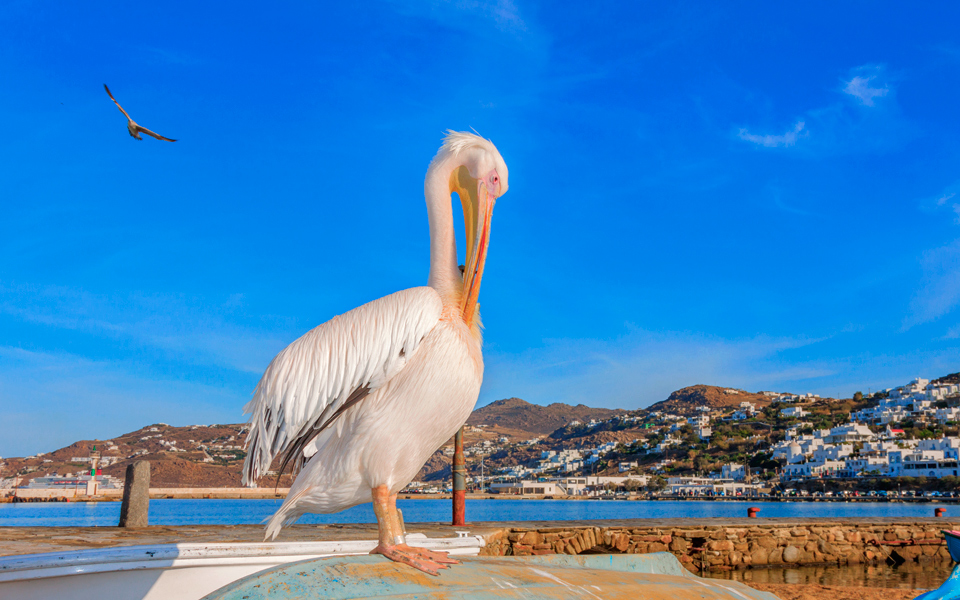To be brutally honest, that bird kind of freaks me out. I type the words at my own peril, as I could be risking banishment from my beloved island for putting such sacrilege down in print. However, truth be told, when our paths cross in the port area, I try my best to avoid Petros, the Pelican of Mykonos. Or rather, one of the island’s pelicans, as there are now more than one.
Petros, the wounded pelican that was rescued and adopted by a Myconian fisherman in 1958 was, indeed, a lovely, fascinating creature. His survival is proof of the tenderness that lies beneath the rugged exterior of the islanders. Petros had an extremely interesting personality. He settled on the island. He made friends. Not metaphorically. I mean he really made friends, going with his buddies for a stroll, sitting down with them for some seafood meze, while his human mates enjoyed their wine, tsipouro or a heavily sweetened cup of Greek coffee at the kafeneio. The locals treated him pretty much as a fellow citizen, albeit one too lazy to work for a living. Petros was spoiled rotten by the delicious fish, fresh from the early-morning catch at the port that he received as a treat from nearly everyone.
In the end, as the island gained destination glamor status of unimaginable proportions, Petros the Pelican managed to generate substantial income for his adopted home. By charming locals and tourists alike – posing patiently for a “click” alongside kings, hippies and jetsetters – the tireless and docile bird was soon promoted to island mascot. Pictures, sketches and portraits of him by local artists made their way onto postcards, souvenirs, t-shirts, coffee mugs, cigarette lighters, hotel and restaurant brands and so on. Not bad turnover for a freeloader.
“I mean he really made friends, going with his buddies for a stroll, sitting down with them for some seafood meze, while his human mates enjoyed their wine, tsipouro or a heavily sweetened cup of Greek coffee at the kafeneio.”
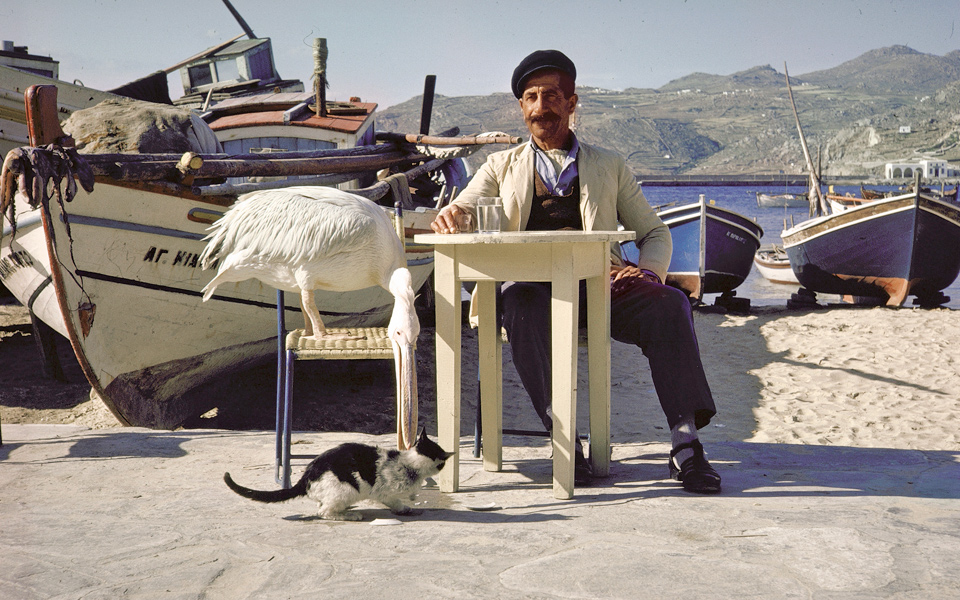
© Dmitri Kessel/Life Collection/Getty Images/Ideal Image
Mykonians rely heavily on livestock, but were never culturally inclined towards keeping animals as pets. However, their adoration for Petros was undeniable. One fine morning, the still young and restless bird decided to fly and visit the nearby island of Tinos. The residents there considered the visit as voluntary migration and decided to keep him. Petros’ alleged entrapment in Tinos was the first (and last) court case in Greece where the custody of a bird was disputed, the avian equivalent of the abduction of Helen of Troy. When the authorities decided in their favor and the captive pelican was returned to them, the Mykonians threw a welcome party with music, dancing and a public feast. Even the solemn Orthodox and Catholic priests (both denominations are present on the island) literally chimed in, festively ringing the bells of all the churches in town.
Petros died in 1985. There is a lot of folklore surrounding the circumstances of his demise, but the only sure thing about his death is that it came at the end of a very long and prosperous pelican life (he was around 30 years old). His death did not leave Mykonos pelican-less. There was already a female, shipped from Florida at the zenith of his glory to keep him company, sent as a gift by Jackie Kennedy Onassis, who had also fallen under the bird’s spell. In addition, the Hamburg Zoo is said to have provided a pelican, who became known as Petros II. This pelican was very good at his job as successor and achieved stardom status so quickly, that an official stand-in, Dimos, had to be recruited for special occasions and tours abroad. At some point, there were three or more Petros the Pelicans roaming the streets of Chora – not all of them male, but then, who notices such things in Mykonos?
Pelicans are not indigenous to this part of the Aegean and the original feathered “King of Mykonos” bore no natural children, despite wholehearted matchmaking efforts with two different females. His first mate died, and the second candidate, Irini, was an ill-fated match for him: Petros refused to mate with her, despite the long years they spent together as the sole male and female pelicans in Mykonos. And enough with the “Gay Petros” theory – the joke is so old, nobody laughs anymore.
FUN FACT
The original Petros is embalmed and exhibited in Mykonos Μuseum.
Τhe live birds, when not strutting around the main port promenade, usually hang out by Nikos’ Taverna, in the Porta area, near Little Venice.
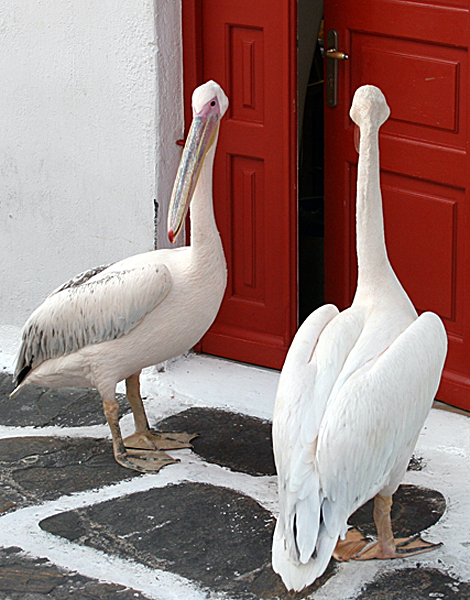
© Shutterstock
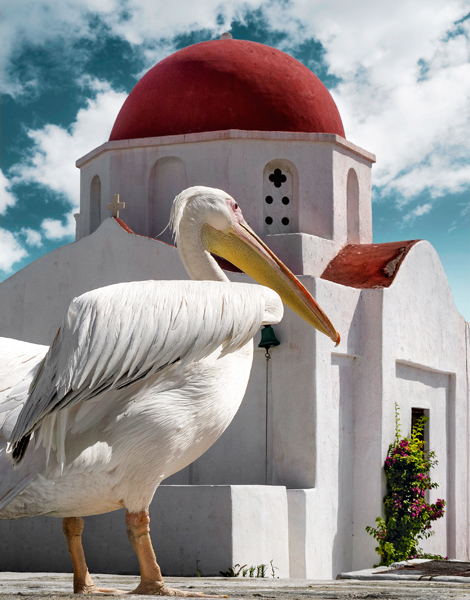
© Giannis Giannelos
The birds that followed Petros I and II all had different personalities. Too shy, or too over-demanding, one or two of them were even accused of having, at times, exhibited downright sociopathic tendencies. Pelicans are big creatures – strong, smart and fast – and the power of their angry beak when they panic is not to be taken lightly. The Cycladic island is not their natural habitat and, were it not for the steady import of new birds, the Mykonos pelicans would have gone dodo on us a long time ago.
On an even darker note, this forever young, forever vibrant, octopus-eating, Petros-like undead creature which has outlived all the people that originally loved and raised him, is not a concept I like, especially during a serious hangover, when I end up portside for an omelet and a hair of the dog.
On the other hand, can you blame the birds? The serene, sparsely inhabited fishermen’s island that took in the original Petros in the mid-1950s was a very different place to the glamorously crowded, music-pumping, traffic-congested destination that is the Mykonos of today. So, when I say that the modern-day pelicans creep me out, I guess I mean exactly the opposite: it is the birds that naturally are upset with me. Or the hundreds of thousands of visitors flooding a place that is not even their natural habitat either.
“The serene, sparsely inhabited fishermen’s island that took in the original Petros in the mid-1950s was a very different place to the glamorously crowded, music-pumping, traffic-congested destination that is the Mykonos of today.”
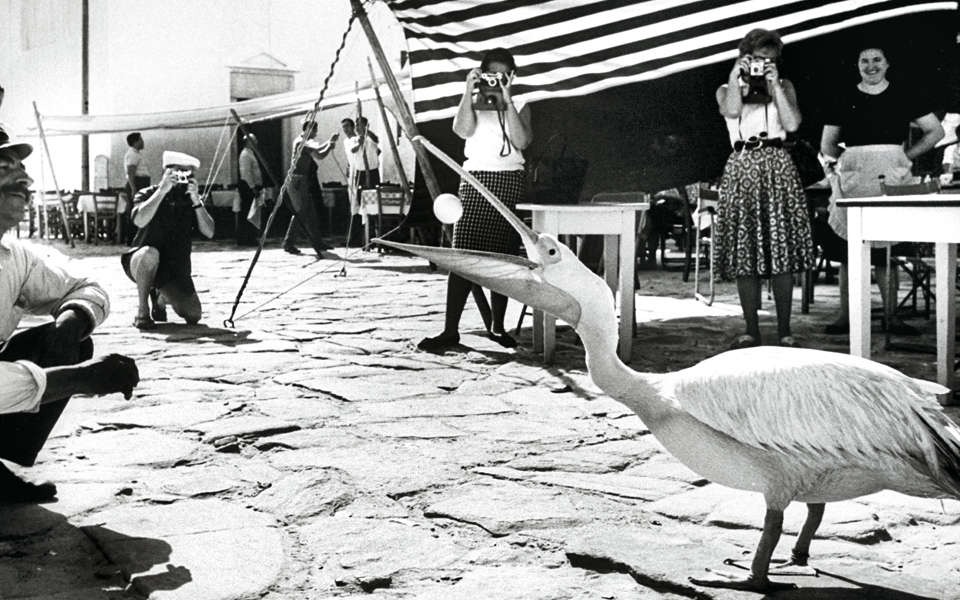
© James Burket/Life Collection/Getty Images/Ideal Image
After too many summers to count spent on the island (a few of my own feathers now ruffled with age), I have come to a deeper understanding of why Petros managed to rise to such mythical status, reaching a point where he effectively overshadowed many of the impressive local symbols, such as the marble lions of Delos and the whitewashed, stone-carved churches. At one stage, he almost competed in worldwide recognition with the perennial landmarks of the island, the famous windmills.
My theory is that Petros arrived in Mykonos at a very young age. He was lost and he was found. He was wounded and healed. He came to call “home” a poor, unknown barren island, far away from his birthplace. He made friends with the humblest of the humble locals and was petted by Brigitte Bardot and the Persian Queen Soraya. He chose his partners, who were not necessarily the ones that nature, or society, dictated. He got in some serious trouble and got away by the skin of his beak. He ate the best food a pelican (or a human) could ever dream of. He was an anomaly, a stranger, a welcome misfit. The island shaped him into a very different pelican than the one he would have been had he been rescued by someone else, somewhere else.
Petros lived the perfect Mykonian adventure: this unique essence of “anything is possible” that still hangs in the island air, still waves elusively from somewhere around the next bend and still rises with every full moon in August.
Petros the Pelican had the time of his life in Mykonos.
For life.
“Petros lived the perfect Mykonian adventure: this unique essence of “anything is possible” that still hangs in the island air”

